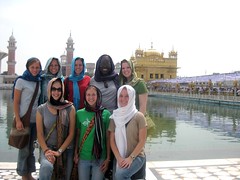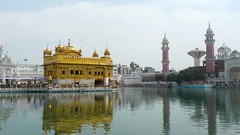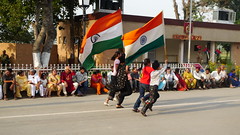 Amritsar proved to be a very interesting learning experience for me. While it wasn’t my favorite city, we saw some fascinating sights. Our first stop in the city was Jallianwala Bagh, or the site of the Amritsar Massacre. I first remember learning about this in high school when we watched the movie “Ghandi,” but to now be in the place where that event took place was very surreal for me. We entered through the one and only entrance, which was where British troops fired their arms into the innocent crowd. As we walked through the area we saw the well that many jumped into to get away from the madness. They had also preserved the walls which had many bullet marks on them. In the middle was a monument set up to commemorate the lives lost at this spot. As I walked around and soaked it all in, everything I learned became more real and more vivid to me. There is something about being there and learning about the event that made it so much better than simply reading about it in a book.
Amritsar proved to be a very interesting learning experience for me. While it wasn’t my favorite city, we saw some fascinating sights. Our first stop in the city was Jallianwala Bagh, or the site of the Amritsar Massacre. I first remember learning about this in high school when we watched the movie “Ghandi,” but to now be in the place where that event took place was very surreal for me. We entered through the one and only entrance, which was where British troops fired their arms into the innocent crowd. As we walked through the area we saw the well that many jumped into to get away from the madness. They had also preserved the walls which had many bullet marks on them. In the middle was a monument set up to commemorate the lives lost at this spot. As I walked around and soaked it all in, everything I learned became more real and more vivid to me. There is something about being there and learning about the event that made it so much better than simply reading about it in a book.
Amritsar is known for its large Sikh population, so it was only appropriate to visit the Sikh Golden Temple, known as Sri Harminder Sahib. After covering our heads and washing our hands and feet,  we entered the temple to find a holy pool with a bright golden temple in the middle. I have found that every religion in India is much different from the next and the Sikh religion is not exempt from that. The thing that makes the Sikhs unique is their belief in service. We witnessed this at lunch we ate in a building next to the temple. Thousands are served everyday from this building. We ate this meal sitting on the floor with our plates in front of us. Very swiftly and efficiently they came around and served us our food. It was quite a unique experience eating in that setting, but it gave me a very small glimpse at their firm belief in service.
we entered the temple to find a holy pool with a bright golden temple in the middle. I have found that every religion in India is much different from the next and the Sikh religion is not exempt from that. The thing that makes the Sikhs unique is their belief in service. We witnessed this at lunch we ate in a building next to the temple. Thousands are served everyday from this building. We ate this meal sitting on the floor with our plates in front of us. Very swiftly and efficiently they came around and served us our food. It was quite a unique experience eating in that setting, but it gave me a very small glimpse at their firm belief in service.
These two experiences in this one city have allowed me to further understand India’s rich and diverse history.
-Rachel Kolb
 After a long and exhausting day of touring around Amritsar, I wasn’t too excited about a 30 km drive to the Wagah Border. Our journey from Dharamsala to Amritsar the previous day had several close calls on the road, so the prospect of venturing out on the “highway” again didn’t seem all that appealing. My interest peaked when our tour guide pointed out the several kilometer long line of produce trucks waiting for days to cross into Pakistan. Only 40 trucks are allowed to cross each day, so often the produce, especially tomatoes, goes bad before it crosses. This was the first visible sign of division, at least that I had noticed, between these two countries with a long history of being divided.
After a long and exhausting day of touring around Amritsar, I wasn’t too excited about a 30 km drive to the Wagah Border. Our journey from Dharamsala to Amritsar the previous day had several close calls on the road, so the prospect of venturing out on the “highway” again didn’t seem all that appealing. My interest peaked when our tour guide pointed out the several kilometer long line of produce trucks waiting for days to cross into Pakistan. Only 40 trucks are allowed to cross each day, so often the produce, especially tomatoes, goes bad before it crosses. This was the first visible sign of division, at least that I had noticed, between these two countries with a long history of being divided.
Upon exiting the bus we had to walk a little ways and be searched before arriving at the stadium where we would watch a 30 minute border ceremony. I could feel the excitement growing with each step as we approached. We entered to find ourselves in a stadium divided not only by the road running lengthwise, but also by a large wall and gate separating the Indian and Pakistani sides. On our side the BSF (Border Security Force) men, all at least 6 feet tall and in hats that made them look even taller, directed us to our seats. While we waited for the ceremony to begin, there was music and some people got up to dance.
Once the ceremony started, more BSF men came out to perform high-kicking marches, blow a horn, and do some impressive yelling as they opened the gates between the two countries. An MC also led the crowd in some Hindustan cheers to build the excitement as the two sides lowered their flags for the night. As I watched the ceremony, I gazed across the border and realized that there were significantly more people gathered on the Indian side. The difference in the lives of the people from these two countries that were once one struck me as sad in that moment. While this performance was about crossing borders, it still emphasized division. I am glad to be part of a program helping to build bridges of global understanding, rather than highlighting differences.
-Andrea Bowman